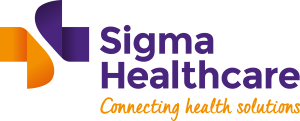CASE STUDY
Sigma Healthcare
Simplifying the business of medicine: Transforming for better business outcomes

INDUSTRY: HEALTHCARE & LIFE SCIENCES
Sigma Healthcare is a leading full line wholesale and distribution business to community and hospital pharmacies in Australia. The company employs more than 1,140 people and services more than 4,000 pharmacies through ten distribution centres throughout Australia.
Its priorities are to respect the diversity and values of its customers, to combat ageism, and support older Australians so they feel valued and connected. The Office showcases age-friendly customer service and is leading the way for other government agencies by defining and demonstrating best practice.
THE CHALLENGE
As part of a Community Service Obligation deed, Sigma provides retail pharmacies a single access point for all 6,000 PBS medications (including S100, Generics and Private Label products). This responsibility includes delivering medicines within a 24-hour time frame while navigating a complex regulatory environment for distribution. Sigma relies heavily on cost-effective wholesale and distribution solutions, and close collaboration with suppliers and customers across aged care, hospitals, pharmacies, distributors and logistics companies.
Sigma Healthcare is a large, dispersed and complex organisation, serving a range of diverse customer types. While some complexity across the business was necessary, other types were not required and were having a negative impact. Past acquisitions and transformation projects left the business with eight different CRM systems, many of them in isolation or too old to be maintained.
Since its wholesale business and subsidiaries act as retailers, Sigma also needed to deliver better customer experiences and find new ways of building brand loyalty. Some teams were managing their sales pipeline through cumbersome spreadsheet software and manual collaboration.
With further complications and constraints added by the COVID-19 pandemic, Sigma understood the urgent need to digitise further and bring its disparate systems together. With no centralised customer data or consistency across sales processes, the team needed urgent creative solutions to improve access, efficiency and customer service.
THE SIMPLUS SOLUTION
PHASe 1
Community Pharmacy
They began by creating a single, central CRM solution and establishing near real-time reporting and standardising sales processes across the business. The team also set up custom processes and integrations using custom meta-data, empowering internal teams to tweak configurations later without the need for a system integrator.
PHASE 2
Hospitals, Aged Care, Distributors and 3PL/4PL
This phase saw Sigma and Simplus extend the single CRM out to their wider network. They created walled gardens, implementing Chatter and platform sharing capabilities to enable collaboration between business units. Simplus also designed a model to use a single Salesforce account but allow multiple related trading accounts in order to keep all the information together.
PHASE 3
ERP migration readiness
The final phase helped ensure Sigma’s ERP met all requirements while providing crucial access. They had been using a green-screen ERP that was blocking access to customer information and reducing efficiency. Simplus created out-of-the-box and bespoke solutions, including custom Mulesoft solutions that resolved ERP data visibility issues and file storage integrations.
THE OUTCOME
Sigma is now in the final stages of a major infrastructure investment program and has set the foundations for a more agile, adaptable and efficient business. Positive business outcomes and performance include:
- A central collaboration platform for all of Sigma’s sales, customer service and front-of-house teams
- Retail and Wholesale teams are collaborating with supplier partners more effectively
- Better relationships with existing customers, reflected in higher net promoter scores with pharmacies
- Expanded organic growth of new pharmacy business
- More sophisticated support for better health outcomes throughout customers’ communities
- Comprehensive real-time reporting and forecasting capabilities, replacing week-long delays
- Better territory management across the business units and understanding of their call cycles
- Removed manual collaboration and enabled digital through Chatter and Activity management
- Reporting features detailed analysis and identification of opportunitiesF
- Fully automated onboarding supports processes that improve visibility
- Better customer experiences via improved issue resolution time, greater consistency across the entire customer journey, and greater collaboration across varied business units.
